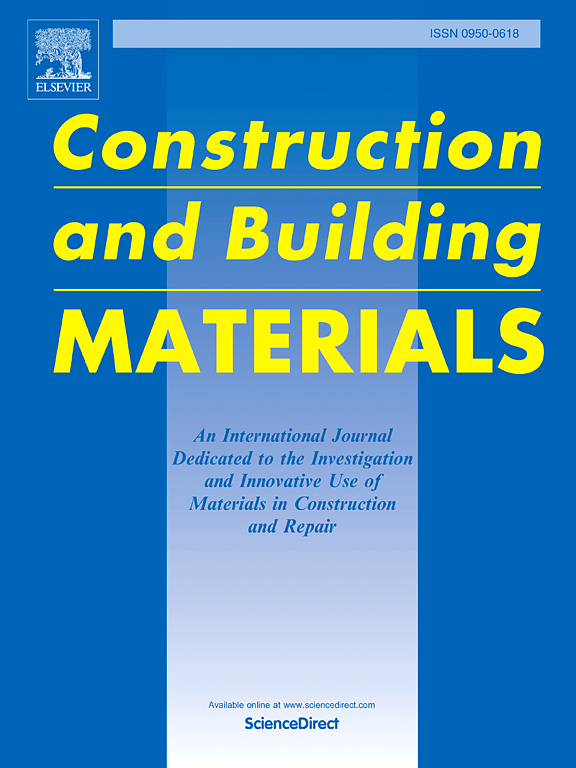Investigation of fracture performance of top-down cracks and bottom-up cracks for nano-silica modified stone matrix asphalt using semi-circular bending test
IF 8
1区 工程技术
Q1 CONSTRUCTION & BUILDING TECHNOLOGY
引用次数: 0
Abstract
Stone matrix asphalt (SMA) is a gap-graded asphalt mixture with a higher percentage of filler, designed for roads with high-volume and heavier axle loads. Top-down cracks (TDC) and bottom-up cracks (BUC) are two types of cracks occurring in SMA, which are caused by fatigue of the surface layer and construction factors, respectively. Despite the good performance of SMA mixes against BUC, the TDCs are as challenging as BUCs, especially in mountainous areas where SMA experiences severe temperature changes and frost heave. To address this concern, this study used low doses of nano-silica to improve the fracture properties of TDCs and BUCs in SMA mixtures. SMA and SMA reinforced with 0.3 % and 0.6 % nano-silica were subjected to freeze-thaw (F-T) damage to study the time-dependent properties of these two types of pavements compared to the base SMA. In addition to the laboratory studies, a numerical analysis was conducted to model the cracking performance of specimens containing angle cracks under tensile-shear loading state; hence, the short- and long-term fracture behavior of vertical and angular cracks was studied to prioritize the critical crack type. Finally, the fracture performance of specimens with and without nano-silica was compared at different temperatures and conditions. The short-term results showed that nano-silica improved the fracture properties of TDCs and BUCs at −15 °C and +15 °C. At −15 °C and under 0 F-T cycles, the fracture energy (FE) values for the mixes modified with 0.3 % and 0.6 % nano-silica increased by 5 % and 16 %, 7 % and 6 %, and 9 % and 13 % under modes II, I+II, and I, respectively. These increases were 13 % and 19 %, 15 % and 25 %, and 23 % and 35 %, respectively, based on the fracture toughness (KiC). At +15 °C and under 0 F-T cycle, the FE values for the mixes modified with 0.3 % and 0.6 % nano-silica increased by 18 % and 30 %, 7 % and 17 %, and 7 % and 18 % under modes II, III, and III, respectively. These increases were 12 % and 25 %, 11 % and 21 %, and 17 % and 40 %, respectively, based on the KiC. Also, the long-term results showed that imposing F-T failure caused a decline in the fracture specification of TDCs and BUCs (both temperatures); however, nano-silica improved the results, as confirmed by the functional groups obtained from the Fourier Transform Infrared Spectrometer (FTIR) test. Regarding critical crack, it was documented that cracks of tensile, tensile-shear, and shear origin were the most essential conditions, respectively. Finally, increasing the temperature resulted in an increase in FE, a decrease in KiC, a boost in flexibility, and a reduction in stiffness under various conditions. Based on this study's findings, SMA mixes reinforced with 0.3 % and 0.6 % nano-silica can be used in cold-temperate and tropical regions, respectively.
采用半圆弯曲试验研究纳米二氧化硅改性石基沥青自上而下裂缝和自下而上裂缝的断裂性能
石基沥青(SMA)是一种具有较高填充率的间隙级配沥青混合料,设计用于高容量和较重轴载的道路。自顶向下裂纹(TDC)和自底向上裂纹(BUC)是SMA中出现的两种裂纹类型,它们分别是由表层疲劳和施工因素引起的。尽管SMA混合料对BUC具有良好的性能,但tdc与BUC一样具有挑战性,特别是在SMA经历严重温度变化和霜胀的山区。为了解决这一问题,本研究使用了低剂量的纳米二氧化硅来改善SMA混合物中tdc和buc的断裂性能。通过对SMA和添加0.3 %和0.6 %纳米二氧化硅的SMA进行冻融损伤,研究这两种类型的路面与基础SMA相比的时间依赖特性。在实验室研究的基础上,对含角裂纹试件在拉剪加载状态下的开裂性能进行了数值模拟;因此,研究了垂直和角裂纹的短期和长期断裂行为,优先考虑临界裂纹类型。最后,比较了不同温度和条件下含纳米二氧化硅和不含纳米二氧化硅试样的断裂性能。短期结果表明,纳米二氧化硅在- 15°C和+15°C时改善了TDCs和buc的断裂性能。在- 15°C和0次F-T循环下,加入0.3 %和0.6 %纳米二氧化硅的混合料在模式II、I+II和I下的断裂能(FE)值分别提高了5 %和16 %,7 %和6 %,9 %和13 %。根据断裂韧性(KiC),分别增加了13 %和19 %,15 %和25 %,23 %和35 %。在+15°C和0 F-T循环下,添加0.3 %和0.6 %纳米二氧化硅的混合料在模式II、III和III下的FE值分别提高了18 %和30 %,7 %和17 %,7 %和18 %。以KiC为基准,分别增加了12 %和25 %,11 %和21 %,17 %和40 %。此外,长期研究结果表明,施加F-T破坏会导致tdc和buc的裂缝规格下降(两种温度);然而,纳米二氧化硅改善了结果,从傅里叶变换红外光谱仪(FTIR)测试中得到的官能团证实了这一点。对于临界裂纹,分别认为拉伸裂纹、拉伸-剪切裂纹和剪切源裂纹是最基本的条件。最后,在各种条件下,温度的升高导致了FE的增加,KiC的降低,柔韧性的提高和刚度的降低。基于本研究结果,添加0.3 %和0.6 %纳米二氧化硅的SMA混合料可分别用于寒温带和热带地区。
本文章由计算机程序翻译,如有差异,请以英文原文为准。
求助全文
约1分钟内获得全文
求助全文
来源期刊

Construction and Building Materials
工程技术-材料科学:综合
CiteScore
13.80
自引率
21.60%
发文量
3632
审稿时长
82 days
期刊介绍:
Construction and Building Materials offers an international platform for sharing innovative and original research and development in the realm of construction and building materials, along with their practical applications in new projects and repair practices. The journal publishes a diverse array of pioneering research and application papers, detailing laboratory investigations and, to a limited extent, numerical analyses or reports on full-scale projects. Multi-part papers are discouraged.
Additionally, Construction and Building Materials features comprehensive case studies and insightful review articles that contribute to new insights in the field. Our focus is on papers related to construction materials, excluding those on structural engineering, geotechnics, and unbound highway layers. Covered materials and technologies encompass cement, concrete reinforcement, bricks and mortars, additives, corrosion technology, ceramics, timber, steel, polymers, glass fibers, recycled materials, bamboo, rammed earth, non-conventional building materials, bituminous materials, and applications in railway materials.
 求助内容:
求助内容: 应助结果提醒方式:
应助结果提醒方式:


